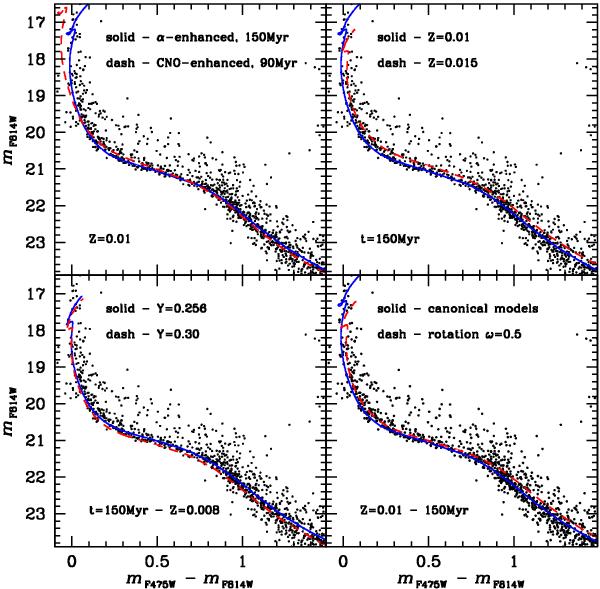Fig. 11

Top left: comparison between the observed CMD of NGC 1844 and suitable theoretical isochrones for an age of 150 Myr and 90 Myr for two different assumptions about the heavy-element mixtures, an α-enhanced mixture ([α/Fe] = + 0.4, solid blue line), and a CNO-enhanced mixture (dashed red line), both with the same iron content [Fe/H] = −0.6. In this comparison we assumed (m − M)F814W = 18.52 and E(mF475W − mF814W) = 0.15 for both isochrones. Top-right: in this case the two isochrones have the same α-enhanced mixture but different metallicities, namely Z = 0.01 and Z = 0.015. Bottom left: in this case the two isochrones have the same metallicity, Z = 0.008, but two different initial He abundances. In this last case we adopted (m − M)F814W = 18.40. Bottom-right: comparison between the NGC 1844 MS and the same isochrone (α-enhanced, 150 Myr, Z = 0.01) adopted in the top left panel (solid blue line). To investigate the impact of stellar rotation, we also show the same isochrone modified according to the Bastian & De Mink (2009) recipes to take into account the effect of rotation (dashed red line). (See text for more detail).
Current usage metrics show cumulative count of Article Views (full-text article views including HTML views, PDF and ePub downloads, according to the available data) and Abstracts Views on Vision4Press platform.
Data correspond to usage on the plateform after 2015. The current usage metrics is available 48-96 hours after online publication and is updated daily on week days.
Initial download of the metrics may take a while.


